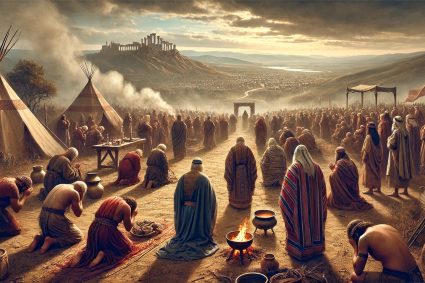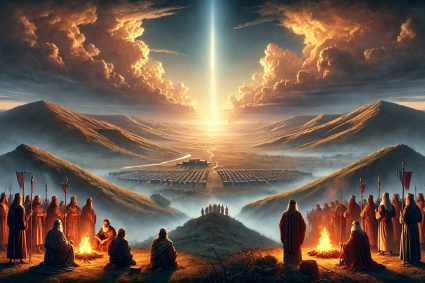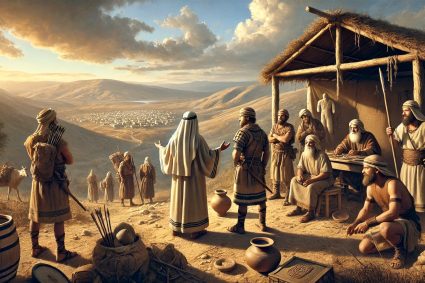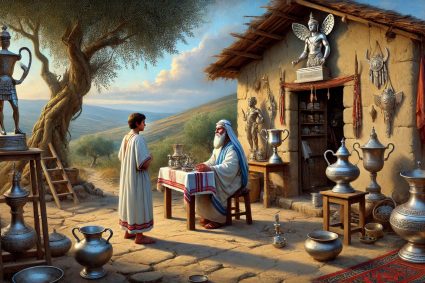
August 8, 2024
DAILY BIBLE READING – Matthew Chapter 9
1 And he entered into a ship, and passed over, and came into his own city.
2 And, behold, they brought to him a man sick of the palsy, lying on a bed: and Jesus seeing their faith said unto the sick of the palsy; Son, be of good cheer; thy sins be forgiven thee.
3 And, behold, certain of the scribes said within themselves, This man blasphemeth.
4 And Jesus knowing their thoughts said, Wherefore think ye evil in your hearts?
5 For whether is easier, to say, Thy sins be forgiven thee; or to say, Arise, and walk?
6 But that ye may know that the Son of man hath power on earth to forgive sins, (then saith he to the sick of the palsy,) Arise, take up thy bed, and go unto thine house.
7 And he arose, and departed to his house.
8 But when the multitudes saw it, they marvelled, and glorified God, which had given such power unto men.
9 And as Jesus passed forth from thence, he saw a man, named Matthew, sitting at the receipt of custom: and he saith unto him, Follow me. And he arose, and followed him.
10 And it came to pass, as Jesus sat at meat in the house, behold, many publicans and sinners came and sat down with him and his disciples.
11 And when the Pharisees saw it, they said unto his disciples, Why eateth your Master with publicans and sinners?
12 But when Jesus heard that, he said unto them, They that be whole need not a physician, but they that are sick.
13 But go ye and learn what that meaneth, I will have mercy, and not sacrifice: for I am not come to call the righteous, but sinners to repentance.
14 Then came to him the disciples of John, saying, Why do we and the Pharisees fast oft, but thy disciples fast not?
15 And Jesus said unto them, Can the children of the bridechamber mourn, as long as the bridegroom is with them? but the days will come, when the bridegroom shall be taken from them, and then shall they fast.
16 No man putteth a piece of new cloth unto an old garment, for that which is put in to fill it up taketh from the garment, and the rent is made worse.
17 Neither do men put new wine into old bottles: else the bottles break, and the wine runneth out, and the bottles perish: but they put new wine into new bottles, and both are preserved.
18 While he spake these things unto them, behold, there came a certain ruler, and worshipped him, saying, My daughter is even now dead: but come and lay thy hand upon her, and she shall live.
19 And Jesus arose, and followed him, and so did his disciples.
20 And, behold, a woman, which was diseased with an issue of blood twelve years, came behind him, and touched the hem of his garment:
21 For she said within herself, If I may but touch his garment, I shall be whole.
22 But Jesus turned him about, and when he saw her, he said, Daughter, be of good comfort; thy faith hath made thee whole. And the woman was made whole from that hour.
23 And when Jesus came into the ruler’s house, and saw the minstrels and the people making a noise,
24 He said unto them, Give place: for the maid is not dead, but sleepeth. And they laughed him to scorn.
25 But when the people were put forth, he went in, and took her by the hand, and the maid arose.
26 And the fame hereof went abroad into all that land.
27 And when Jesus departed thence, two blind men followed him, crying, and saying, Thou son of David, have mercy on us.
28 And when he was come into the house, the blind men came to him: and Jesus saith unto them, Believe ye that I am able to do this? They said unto him, Yea, Lord.
29 Then touched he their eyes, saying, According to your faith be it unto you.
30 And their eyes were opened; and Jesus straitly charged them, saying, See that no man know it.
31 But they, when they were departed, spread abroad his fame in all that country.
32 As they went out, behold, they brought to him a dumb man possessed with a devil.
33 And when the devil was cast out, the dumb spake: and the multitudes marvelled, saying, It was never so seen in Israel.
34 But the Pharisees said, He casteth out devils through the prince of the devils.
35 And Jesus went about all the cities and villages, teaching in their synagogues, and preaching the gospel of the kingdom, and healing every sickness and every disease among the people.
36 But when he saw the multitudes, he was moved with compassion on them, because they fainted, and were scattered abroad, as sheep having no shepherd.
37 Then saith he unto his disciples, The harvest truly is plenteous, but the labourers are few;
38 Pray ye therefore the Lord of the harvest, that he will send forth labourers into his harvest.
King James Version. Public Domain
Commentary
Introduction:
Matthew Chapter 9 contains an impressive collection of miracles and teachings of Jesus that emphasize his divine power and deep compassion for humanity. In this chapter, we see Jesus healing a paralytic, calling Matthew to follow him, healing the woman with a bleeding disorder, raising Jairus’s daughter from the dead, healing two blind men, and delivering a mute man from a demon. These stories not only demonstrate Jesus’ ability to heal physical ailments but also his power to forgive sins and bring spiritual healing. It becomes evident that Jesus came to care for those who were considered outcasts by society.
Commentary:
Matthew 9 is a powerful chapter that highlights the versatility of Jesus’ ministry. It begins with the healing of the paralytic, where Jesus makes it clear that he brings not only physical healing but also the forgiveness of sins. This action provokes the scribes, as they realize that Jesus is claiming divine authority. This is a central point in Jesus’ mission—the connection between physical healing and spiritual redemption.
The calling of Matthew and the subsequent meal with tax collectors and sinners underscore Jesus’ mission to reach those who are most lost and excluded. The Pharisees’ criticism of Jesus for eating with sinners is met with a powerful response: “Those who are well have no need of a physician, but those who are sick.” This statement highlights Jesus’ missionary purpose—the salvation of those who recognize their need.
The healing of the woman with the bleeding disorder and the raising of Jairus’s daughter demonstrate the value of faith and the transformative power of Jesus. The woman, who suffered for years, is healed by her faith, and Jairus’ deep belief in Jesus’ power leads to the resurrection of his daughter. This emphasizes the importance of faith in receiving healing and salvation.
Finally, the healing of the two blind men and the mute demoniac shows that Jesus can dispel not only physical but also spiritual darkness. These miracles cause the people to marvel at Jesus’ power, while the Pharisees remain in their rejection, illustrating a sharp divide between those who believe in Jesus and those who oppose him.
Summary:
Matthew Chapter 9 reveals the deep connection between physical healing and spiritual redemption that Jesus brings. Through healing the sick, forgiving sins, and raising the dead, Jesus demonstrates his power and mercy. This chapter reminds us that Jesus came to seek and save the lost, and that faith is the key to receiving his healing power. Jesus makes it clear that true healing and redemption encompass both physical and spiritual dimensions, inviting us to follow him with an open heart and deep faith.
![]()

WEEKLY SPIRIT OF PROPHECY READING – Ellen White | The Desire of Ages Chapter 52: The Divine Shepherd
This chapter is based on John 10:1-30.
Read online here
Commentary
In John 10:1-30, Jesus Christ reveals Himself as the “Good Shepherd,” a metaphor deeply rooted in the culture and hearts of the people of His time. This familiar image of a shepherd lovingly and protectively watching over his flock serves as a powerful parable for the close, personal relationship that Jesus maintains with His believers. He is not just a shepherd, but the Shepherd who is willing to lay down His life for His sheep—an expression of the highest form of love and devotion.
The promise that the Good Shepherd knows His sheep by name highlights the deep personal bond that Jesus has with each individual believer. He knows our worries, our fears, and our struggles. In a world full of uncertainties, the Good Shepherd offers security, guidance, and comfort. Jesus contrasts Himself sharply with the false shepherds of His time, who led the people astray and neglected their responsibility to the flock.
Through the image of the shepherd who goes ahead and leads his sheep to safe pastures, Jesus illustrates that the way to God cannot be reached through human wisdom or religious systems, but only through Him. He is the door to life, and only through Him can we find true fulfillment and peace. This image of the Shepherd who fights for and protects His sheep conveys the deep comfort and security found in following Jesus.
The Good Shepherd not only lays down His life for the sheep but also takes it up again to grant them eternal life. This willingness to sacrifice Himself shows the deep love of Jesus, a love that knows no bounds. It is a love that follows us into our darkest moments, rescues us from lostness, and leads us into fellowship with God.
Jesus’ call to follow His voice is an invitation to a life of abundance—a life characterized by His guidance and care. In Him, we find not only protection and provision but also the assurance that He will never abandon us. This Shepherd, who leads us through life, will ultimately bring us to our eternal home, where we will find complete security and joy in His presence.

WEEKLY SPIRIT OF PROPHECY READING – Ellen White | The Desire of Ages Chapter 53: The Last Journey From Galilee
This chapter is based on Luke 9:51-56; Luke 10:1-24.
Read online here
Commentary
In Chapter 53 the final journey of Jesus from Galilee to Jerusalem is depicted, a journey marked by both internal and external challenges. With the foreknowledge of His impending suffering and death, Jesus altered His approach, deliberately turning toward the cross. Whereas He had previously avoided the attention of the masses, He now openly presented Himself, preparing the people for the impending climax of His earthly mission.
On this last journey through Galilee, Jesus taught intensively, using many parables to convey His message and prepare His disciples for the coming events. Despite the growing hostility from the religious leaders, Jesus remained steadfast in His mission, resolutely setting His face toward Jerusalem, fully aware that His sacrifice was necessary to save humanity.
The people’s reactions to Jesus’ final journey were mixed. While some readily accepted His teachings, others met Him with rejection and hostility. The Samaritans, who did not receive His message, and the cities that ignored His works and teachings, became cautionary examples of the danger of rejecting God’s offer of salvation.
This chapter highlights Jesus’ determination and obedience to the will of His Father, as well as His deep love and care for humanity. It shows us that the path of obedience and devotion is not always easy, but it ultimately leads to the fulfillment of God’s divine plan. The words and actions of Jesus on this final journey remind us that the true treasure lies in heaven and that if we set our hearts on God, we can become part of His eternal kingdom.
Visited 31 times, 1 visit(s) today






